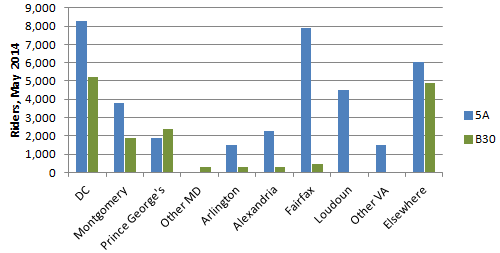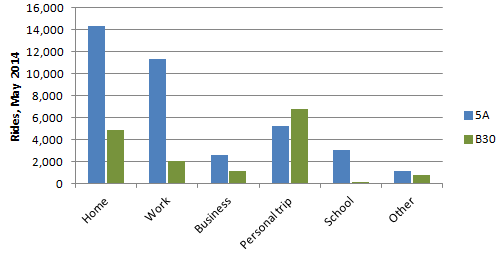Here’s who rides the bus to the airport, and why
The 5A and B30 buses take people to Dulles and BWI airports, in Virginia and Maryland, respectively. Do these just serve residents of those states, or everyone? Are they mainly for air travelers, or others? New graphs from PlanItMetro shed light on this.
The data for these charts comes from a recent survey of bus riders. They show that that the 5A riders are 47% from Virginia, 22% DC, and 15% Maryland, while B30 riders are 29% Maryland, 33% DC, and 7% Virginia.
The B30 serves a lot more air travelers than the 5A, which does double duty as a commuter bus for people working at the airport and people going from Herndon to downtown DC. That’s because the 5A goes into downtown DC, to L’Enfant Plaza, while the B30 ends in Greenbelt.
You can also see that the B30 has more riders from outside our region (31%) than the 5A in the top chart.
One piece of information you can’t see from these pie charts is that the 5A carries about twice as many passengers as the B30. I made these graphs into bar graphs based on May 2014 ridership:

As you can see, Montgomery residents actually use the 5A even more than they use the B30, while Prince George’s residents use both about equally even though the B30 starts in Prince George’s County. Virginians, meanwhile, hardly use the B30 at all. That’s not surprising since it’s at the end of the Green Line, a line that doesn’t go into Virginia, while the 5A stops along five Metro lines which all go to Maryland.

This chart shows how the B30 and 5A are about comparable in serving people going on personal air travel, but the 5A gets far more riders going to and from home and work.
What’ll happen with the 5A?
In May, the Hogan Administration (through its WMATA board member Michael Goldman) announced it didn’t want to chip in any money for the 5A bus to Dulles Airport (which, of course, is in Virginia). Goldman threatened to withhold Maryland’s $6 million share of paying for power upgrades if the rest of the board didn’t go along.
Goldman argued that because the bus runs from DC to Virginia without going to Maryland, the state shouldn’t pay. He also pointed out that Maryland fully pays for the B30 bus which runs from Greenbelt to BWI airport.
Metrobus has two types of bus lines: “regional,” where jurisdictions share the cost according to a formula which factors in where bus riders comefrom; and “non-regional,” where one jurisdiction pays the whole cost. The B30 is non-regional, while the 5A has a special formula due to its unusual history.
In the latest budget, the $990,000 annual cost of the 5A is split $405,900 from DC, $188,100 from Maryland, $79,200 from Arlington, $9,900 from Alexandria, and $306,900 from Fairfax.
Riders pushed back against cuts to the 5A, and in a presentation to the board for the November 5 meeting, Metro bus planners are recommending keeping the 5A. Instead, if Maryland wants to save money, the presentation suggests, the B30 bus to BWI airport could be cut.
Maryland may still refuse to pay any money for the 5A, though based on this graph, it seems that shouldering some of the cost, like the current 18% is reasonable since 15% of the riders are from Maryland.
There’s one way Maryland could try to get more out of its investment: Push the airports authority to better support the 5A. At least as of 2013, the authority was refusing to post signs about the 5A, include it in announcements, offer employees SmartBenefits, or have SmarTrip vending machines at the airport. Instead of protecting the Washington Flyer, MWAA can help encourage people to ride the 5A at least until the Silver Line gets to the airport.
Fund regional buses regionally
Anyway, as this data shows, the 5A is more of a commuter bus than an airport bus per se. And it’s one with a strong constituency. It’s a necessary airport link when Metrorail is closed, but the rest of the time, it’s still a bus that many people use, people who will likely still want to keep it when the Metro goes right to Dulles.
Goldman and Maryland do have a legitimate argument that the B30 ought to be consider a regional route, with the cost shared regionally, as other buses. It doesn’t leave Maryland, but it connects regionally-significant destinations. It’s not healthy for jurisdictions to pick and choose which regional routes to fund; Metro should have a regional bus system, with a single formula (which applies to the 5A and B30 as well) for sharing the costs of that regional system.
WMATA planners are already considering changes to redefine “regional” routes with a simpler, clearer formula. Applying that formula to the airport buses could settle the need for this kind of line-specific squabbling that should be beneath the board.


